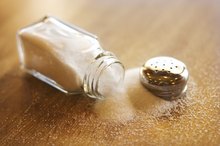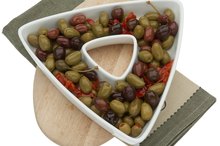Sodium & Oysters
Sodium is found in table salt and almost all foods, and this mineral is essential to your body's healthy functioning. However, excessive sodium intake is cause for concern. Unless you need to follow a very low-sodium diet, oysters are a relatively low-sodium food. If you have a medical condition necessitating a low-sodium diet -- heart failure, Ménière's disease, kidney disease, cirrhosis and diabetes are some examples -- ask your doctor whether it is safe for you to eat oysters.
Nutritional Information
According to the USDA standard nutrient database, a single medium-sized raw Pacific oyster contains 40 calories, 4.7 g of protein, 1.2 g of fat and 2.5 g of carbohydrates 1. A single medium-sized oyster has an average weight of 50 g. Small quantities of calcium, magnesium, iron, potassium, phosphorus, zinc, copper, selenium and manganese are present in a raw oyster. The sodium content of a 50-g raw Pacific oyster is 53 mg.
Variables
Nutritional Content of Canned Oysters
Learn More
Different types of oysters have different nutritional profiles and sodium contents. For example, raw Eastern oysters harvested from the wild contain only 26 calories per 50-g serving, significantly less than the Pacific raw oyster. The protein, fat and carbohydrate content of Eastern oysters is higher than that of Pacific oysters, at 9.5 g, 2.3 g and 5 g, respectively. The sodium content of Eastern oysters is slightly lower than that of Pacific oysters, at 42 mg per 50-g serving. As Eastern oysters are smaller, 50 g represents three to four individual oysters.
- Different types of oysters have different nutritional profiles and sodium contents.
- For example, raw Eastern oysters harvested from the wild contain only 26 calories per 50-g serving, significantly less than the Pacific raw oyster.
Quantities
According to the Mayo Clinic, an upper daily sodium limit for healthy adults is 2,300 mg. In practice, most adults living in the United States consume more sodium than is considered healthy. Excessive sodium intake can lead to a range of health problems, including hypertension, also known as high blood pressure. For optimum health, the Mayo Clinic recommends you consume no more than 1,500 mg of sodium daily. If you ate no other foods containing sodium for the rest of the day, you could maintain a sodium limit of 1,500 mg by consuming either 1,400 g of raw Pacific oysters or 1,785 g of Eastern oysters.
- According to the Mayo Clinic, an upper daily sodium limit for healthy adults is 2,300 mg.
Considerations
Vitamins in Shrimp
Learn More
The sodium values given for raw oysters do not take into account different cooking or preparation methods. The sodium content of canned oysters is higher than that of wild raw oysters -- a 50-g serving of canned oysters contains 66 mg of sodium. Likewise, any dipping sauces or condiments you consume together with oysters can significantly increase the sodium content of the meal. If you have concerns or questions about your health and your sodium intake, contact your health-care provider.
- The sodium values given for raw oysters do not take into account different cooking or preparation methods.
- Likewise, any dipping sauces or condiments you consume together with oysters can significantly increase the sodium content of the meal.
Related Articles
References
- USDA National Nutrient Database for Standard Reference, Release 23
- Mollusks, oyster, Pacific, raw. FoodData Central. U.S. Department of Agriculture. Published April 1, 2019.
- 7 Reasons to Love Oysters-Even If You Hate Them. Cleveland Clinic. Updated 2016.
- Zinc: Fact Sheet for Health Professionals. National Institutes of Health, Office of Dietary Supplements. Updated 2020.
- 10 Tips: Eat Seafood Twice a Week. ChooseMyPlate U.S. Department of Agriculture.
- Ihn HJ, Kim JA, Lim S, et al. Fermented oyster extract prevents ovariectomy-induced bone loss and suppresses osteoclastogenesis. Nutrients. 2019;11(6). doi:10.3390/nu11061392
- Tischmann L, Drummen M, Gatta-Cherifi B, et al. Effects of a high-protein/moderate-carbohydrate diet on appetite, gut peptides, and endocannabinoids-A preview study. Nutrients. 2019;11(10). doi:10.3390/nu11102269
- Kaufman C. Foods to Fight Iron Deficiency. Academy of Nutrition and Dietetics. Updated 2020.
- Shellfish allergy is not a shell game. American Academy of Asthma, Allergy & Immunology. Updated 2020.
- Risks of Eating Raw Oysters and Clams. Virginia Department of Health. Updated 2018.
- Types of oysters. Berkeley Wellness University of California. Updated 2015.
- Dolaski AM. True or False: Only Eat Oysters in Months That End in 'R'. American Council on Science and Health. Updated 2016.
- Phillips KE, Satchell KJ. Vibrio vulnificus: From oyster colonist to human pathogen. PLoS Pathog. 2017;13(1):e1006053. doi:10.1371/journal.ppat.1006053
- Hassard F, Sharp JH, Taft H, et al. Critical review on the public health impact of norovirus contamination in shellfish and the environment: A UK perspective. Food Environ Virol. 2017;9(2):123–141. doi:10.1007/s12560-017-9279-3
Writer Bio
Jae Allen has been a writer since 1999, with articles published in "The Hub," "Innocent Words" and "Rhythm." She has worked as a medical writer, paralegal, veterinary assistant, stage manager, session musician, ghostwriter and university professor. Allen specializes in travel, health/fitness, animals and other topics.









